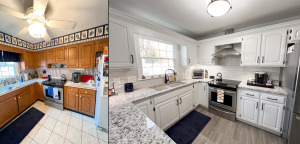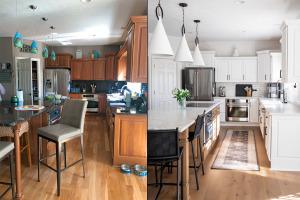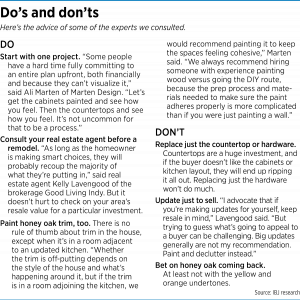Subscriber Benefit
As a subscriber you can listen to articles at work, in the car, or while you work out. Subscribe Now
(Photos courtesy of Jessica Bostic)
In fashion, the 1980s and 1990s are having a resurgence. Not so in kitchen cabinets. The ubiquitous honey oak finish from the Reagan administration is not rad again.
“It’s the sculptured green shag carpet of our generation,” said Indianapolis real estate agent Joe Everhart, adding that his clients who buy a house with these golden oldies assume they will have to renovate.

But don’t rip out yours just yet. Everhart said the cabinets aren’t a lost cause: “People treat them as disposable, which is sad because, more often than not, they’re pretty well-built compared to what you can buy now. Stick with longevity.”
Indianapolis interior designer Ali Marten of Marten Design agreed that well-maintained honey oak cabinets can have a lot of life —and value—left in them.
“There are major cost savings in working with what you have,” she said. “And it’s more sustainable.”
Repainting cabinets is the most common option and the one usually preferred by interior designers and real estate agents for modernizing a home and maximizing the return on investment at resale. But leaving them alone still might be the best choice, depending on your goals.
Doing less could be more

You should get a return on the investment for common updates, like painting the cabinets or toning down their effect with other changes, according to real estate agent Kelly Lavengood of the brokerage Good Living Indy. But money isn’t the only factor.
“Often, people are moving because they are going through a big life change,” she said. “I try to help clients sell their house for the best price and least amount of stress. Doing major projects on a house is not the least amount of stress. It might not be the best return or the most efficient way to bring your house to market.”
For instance, Lavengood said, renovations can eat into any increased market value you might see.
“My No. 1 priority is to clean and declutter,” she said. “That is the powerful thing someone can do to sell their house.”

One step up from doing nothing is toning down the shade of the honey oak. A light face-lift could include changing the color of walls, rugs and window treatments. Stay in the family of white, cream and beige to neutralize the yellow and orange in honey oak.
“There are plenty of ways to give your space a face-lift without having to spend gobs of money replacing or painting [cabinets],” said interior designer Jessica Bostic of inStyle Kitchen and Bath in Columbus.
Professional repainting will cost at least several thousand dollars and usually around $10,000, depending on the amount of cabinetry. Everhart said putting that money into new appliances is just as reasonable and much less hassle.

Minimal approach
But Marten’s advice is to put your dollars toward the most impactful element in the room. In a kitchen, that’s the cabinetry.
If you have a lot of storage, taking out some upper honey oak cabinets will reduce the eyesore, she said. And she suggested swapping cabinets for floating or open shelving.

Everhart said a benefit to removing upper cabinets is that it can be a DIY job. “When you don’t replace the bottom cabinets, you stay away from having to deal with electrical and plumbing. You know how hard it is to get contractors now,” he said.
He recommended going with a tile feature wall and open shelving. “That can be a dramatic update at a much more affordable cost” than a full renovation, he said.
Then you can paint the lower cabinets only, he added, or just leave them alone. If you like a project and aren’t going for resale, some design blogs recommend considering peel-and-stick contact paper to change the look of the lower cabinets. Getting good results is trickier than blogs make it seem, but it should peel off if you don’t like the initial results.
Mid-range moves
Painted cabinets are in style right now, and not just white—although you still can’t go wrong with that clean, neutral look, experts said.
“Painting cabinets is the most efficient and quickest way to give any kitchen a face-lift,” Bostic said. “We all know kitchens and baths sell a home. If a potential buyer walks into a bright, fresh, clean kitchen, they are going to be much more open-minded about the rest of the house.”
Everhart said he considers painting cabinets a DIY job, but beware—it’s not as straightforward as painting walls. You have to fill in the deep grain of the oak or it will show through any paint. Then you have to choose the right primer, paint and sealer so it won’t flake off, and use an air sprayer to avoid bubbles in the paint.
Bostic and Marten are leery of DIY. “It’s a multistep process with appropriate materials to make sure it will last a long time and not just peel off or chip,” Bostic said, adding that painting cabinets professionally runs $10,000 to $12,000.
“There could be countless problems, and you’ll end up hiring someone to fix it,” Marten said.
Lavengood pointed out that a poor DIY job is worse than honey oak cabinets.
Marten said she likes to paint the perimeter cabinetry neutral and save an accent color for the island. “White is always a safe bet, especially if the end goal is resale, because it presents as clean and fresh,” she said. “Even if the person buying it doesn’t like it, it’s an easy canvas to work with. We have done a good bit in the taupe-y range, too. It gives a little bit of color without being polarizing.”
Everhart recently painted his own black cabinets with yellow, using a more intense shade on the trim. “It looks like Monet’s kitchen in Giverny,” he said, referencing the artist’s landmark home in France. “Yellow is the next thing. And that blue that’s between royal and navy.” He said hunter green is also on the way in.
Painted cabinets can call for a new coordinating countertop and wall color, too. “All the trends I’ve seen still lean neutral,” Everhart said. “The maximalists are going back to crazy tile and wallpaper in the kitchen. If you’re like me, just being clumsy with your mixer, it’s a recipe for disaster.”
Experts agree that you’ll get your painting money back on resale, but Lavengood said to consider your specific neighborhood first by consulting your real estate agent on what investment the area can support. “Different price points and different areas can mean very different advice,” she said.
New doors are another option to keep most of what you have. They run about $6,000 installed and painted for an average-size kitchen, according to Mike Jessup of Ideal Cabinetry, Marten’s go-to guy.
High-end choice
Restaining is more labor-intensive and expensive than repainting. The argument for it, Marten said, is that it’s beautiful and high end to have a wood-tone element in the kitchen. A professional can even change the appearance to look like a different species of wood.
“We’ve made cherry cabinets look like white oak or walnut,” Marten said. She estimated it costs $10,000 to $15,000 to restain versus $25,000 to $40,000 for new semi-custom cabinets.
She said she recommends the option even when a client can afford a full remodel. “We had a client with beautiful custom cabinets, but she regretted the cherry stain,” Marten said. “We painted the perimeter cabinets a soft white and restained the island to look more like a deeper-toned white oak versus red.”
Marten also modernized the two-tiered island with an overhang by replacing the legs with shorter ones and converting the counter to a single height.
Dark and light tones go in and out of style. Marten recommended a mid-tone shade. Raw white oak has been popular. “We’ve seen things shift, and we prefer a slightly warmer, deeper tone—almost like a walnut-type color. Coffee, not espresso,” she said.
For resale value, staining makes most sense in high-end homes.
“Painting is going to hit more of the target audience,” Lavengood said. “Painted cabinets are more in style right now than wood-toned cabinets.”•
Please enable JavaScript to view this content.

